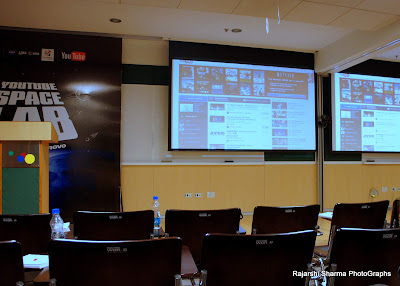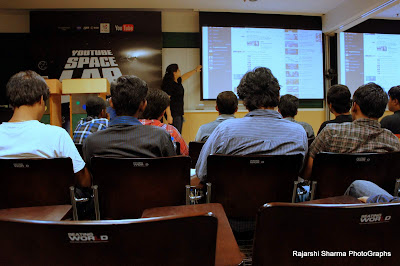So, I went to this Bloggers' Road Show conducted by Google this Saturday, 16th of June 2012. Reaching there was quite a pain since, even though Google's premises in balmy B'lore is quite swanky, the same can't be said about the exact location where the premises be located :). The Bangalore Metro being slothful, slowwww, so slow!, didn't help the cause too much either. After all the needful security checks, generation of name tag etc, I popped in the room around 20 mins into the seminar :). Apparently, didn't miss much 'cos I seemed to latch onto the conversation right away. Anyways, that was the prologue :) getting on with business now...
In the words of the presenter herself, the road show was going to be all about...
The following were some of the bullet points which one gained from the session:
As I end on that very topic-disconnected and mood-swing-y note, I leave you with some pictures of the event and its presentation. 'til l8r...
In the words of the presenter herself, the road show was going to be all about...
"Want to be a YouTube star? Here's your chance to do what you love to do, become a star on YouTube, reach a global audience and even get paid!"(Hah! many lonely vloggers would have loved to have the "P" in the last word of the sentence be replaced with "L" :P )
The following were some of the bullet points which one gained from the session:
- The Indian Demographic of the YouTube "Diaspora" view, on an average of 7-15 videos in a single viewing session.
- Most Indian users (i.e. around 60%) use YouTube for accessing Indian content. (Duh!)
- This is because the recommendation engine for youtube users has been spruced up quite a few notches in the recent past.
- The advertisement generating engine has also been improved it appears and the various types of ads coming into play for YouTube were also discussed.
- The "3 R"s of YouTube were revealed as "Reach. Revenue. Recognition". On a "Content is King" platform like YouTube, the user gets access to these '3 R's.
- The current time limit for uploads is going to be revised pretty soon. But the scrutiny for copyrighted items remain the same.
- Apparently, being a YouTube partner is going to help monetizing on one's original content in YouTube in a better manner than the regular Adsense steam. (I do have my own apprehensions on this. BTW the money generated from being a partner is still going to be tracked and paid with Adsense UI and tools). Revenue breakup will be 55% (YouTube partner) and 45% (YouTube/Google)
- Having one's own channel is one of the important means towards this end.
- The mechanism for becoming a partner is going to come online pretty soon.
- Having original content which is engaging is very very crucial in this case. Couple of videos were shown to illustrate this. Video blogs of Gayatri Vantillu (Houswife/Recipe vlogger) and Michelle Phan (Makeup Artist/vlogger and THE highest earning youtube partner) were shown as examples of people with simple and original content who were making very good amounts of money out of youtube. While on the other hand, Dr. K Chaudhury was quoted as an example of a hugely popular YouTube star who is ineligible for the partnership since his material uses highly copyrighted items (except for the singing which is super original :P lol .. i remember hearing one of his fans saying its easier to tolerate Chinese torture than to endure a round of songs with Dr. KC! :P) . Several very popular bloggers apparently were also quoted as moving to the YouTube medium ever since partnership was announced to them.
- So, its like the medium has given rise to a whole new generation of stars, "The youtube stars" as they are called.
- A thick thick skin for scathing criticism, very important :)(e.g: "I remain in fray because I look at 10 thousand people who like my performance and not at 10 million people who hate my performance. Assessing me as good or bad, you gifted me your precious time – that is what makes me feel obliged to you." ~ Dr. KC at some pointed criticisms in the comments of an American Blog)
As I end on that very topic-disconnected and mood-swing-y note, I leave you with some pictures of the event and its presentation. 'til l8r...




